Mieux vaut déceler une faiblesse que se laisser soupçonner d'un vice. * - Denis Diderot
*(It is better to reveal a weakness than allow oneself be suspected of a vice.)
Marie Antoinette, Queen of France, wife of Louis XVI, lived a life of luxury and extravagance between the majestic château de Versailles and the bucolic Petit Trianon. Her royal privilege and riches allowed her to entertain friends in splendor with society dinners, masked banquets, fashion shows, concerts or plays, elaborate picnics and teas among girlfriends. Enough to lose one’s head.
And while she seemed to prefer a simple, comforting bowl of bone broth or peasant dishes made from the produce of her own farm, she had the reputation for being quite the gourmand, passionately mad for sweets and pastries.
But did Marie Antoinette regale herself on pretty little macarons in an array of colors and flavors? Or did Sofia Coppola use a bit of artistic license in her 2006 film?
Le macaron, made from ground almonds, sugar, and egg whites has existed since the Middle Ages, the combination of ingredients producing a delicate cookie that is moist and tender with a crispy outer crust or shell. While almonds had long been cultivated and used in pastries in Central Asia and the Middle East, slowly making their way to North Africa, Spain, and Greece by the 5th to 7th centuries, the French did not begin to seriously cultivate them until the 16th century, when they quickly became popular. Almonds were used prolifically in cooking as well as pastry, from soup to meat dishes, to desserts. Almonds were grilled, made into sweet paste or candy, caramelized, turned into hypocras, a sweetened wine or fruit-based drink, often spiced, or ratafia, the same except using eau-de-vie. Almond milk became a popular and staple ingredient, often used instead of cow’s or other animal milk which spoiled much more quickly. Eventually, ground almonds were being used to make such things as pastry crusts for tarts and other baked goods, assuming that part of the reason was that flour was reserved to make bread and ground almonds, or almond flour, was a simple, available, and tasty substitute.
We first find ground almonds used to make massepain or marzapane in Italy, a dense candy of almond paste made from almonds, egg whites, and sugar, as far back as the 14th and 15th centuries. By the 16th century, the macaron, our tender little treat in cookie form, arrived in France, or so popular legend has it (we will discuss this further in Part 2 of our macaron post). The macaron existed already in Italy, most notably in Venice, under the name maccherone or macarone, possibly getting its name from the Italian ammaccare, “dent” or “crunch”. Think of the Italian amaretti. Catherine de Médicis, arriving in France in 1533 for her marriage to Henri, duc d’Orléans, the future Henri II, king of France, famously brought her own entourage of cooks and chefs with her, introducing specialities from her country of birth to the country of which she would be queen. And, of course, this novel treat delighted the Court. The same Catherine de Médicis served macarons at the marriage of the Duc Anne de Joyeuse to Marguerite de Lorraine-Vaudémont in Ardèche in 1581; macarons were also offered at the marriage of Louis XIV to the Infante Marie-Thérèse in Saint-Jean-de-Luz in 1660.
Of course, once something becomes all the rage in Court circles, it can’t but be noticed and desired by the upper crust of the population who then carry it back to their own chefs in their own cities and regions.
And so the recipe for the macaron quickly spread throughout the country; by the 18th century, macarons were being made in convents, like our financiers - the small almond-sugar-and-egg-white cake-like cookie made by the Visitandines in Melun, or the macaron de Lorraine by the Dames du Saint-Sacrement. The Dauphin, future Louis XV and his wife the Dauphine were apparently offered macarons among other treats during a visit to the monastery of the Visitation Sainte-Marie in Melun in 1748.
The recipe for macarons was soon adopted… and adapted by pastry chefs in several cities, creating variations on the simple cookie made from 3 simple ingredients: ground almonds, sugar, and egg whites. We find macarons de Nancy, de Niort, de Montmorillon, de Reims, de Boulay, and many more, each taking a different form, yet all still delicate, tender-chewy cookies with the familiar crisp outside made from those same 3 ingredients. Today, there are about 40 regional variations on the macaron in France.
So back to our young Queen and her sweet tooth.
While Marie-Antoinette would most likely have enjoyed macarons, they most definitely would not have been macarons de Paris, the fancy confection in pastel colors we are all so familiar with. While chefs were already icing macarons, flavoring them with orange flower water, or making indentations in them before baking and filling them with fruit jam by at least the 18th century, and Parisian pastry chefs were sandwiching 2 macaron cookies together with a filling by the first half of the 19th century, the fancy colorful little macaron in a variety of flavors we are so familiar with today wouldn’t be created until 137 years after our poor Queen lost her head.
Louis-Ernest Ladurée opened a bakery on rue Royale near Paris’ Madeleine in 1862, eventually recreating his business into a pastry shop after a fire had destroyed the building in 1871. During the 1900 Exposition Universelle, Ladurée’s wife Jeanne had the brilliant idea of fusing pastry shop with traditional Parisian café to create one of the city’s very first salons de thé. And in 1930, Louis-Ernest Ladurée’s great nephew Pierre Desfontaines decided to take the traditional French macaron and recreate it in an image befitting the elegant, sumptuously appointed Ladurée shop, inventing what he called le macaron Parisien, and sandwiching the 2 now colorful, crispy-chewy shells together with ganache.
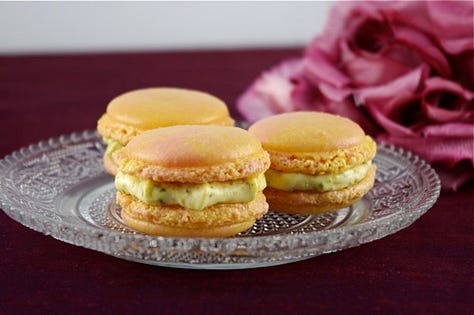
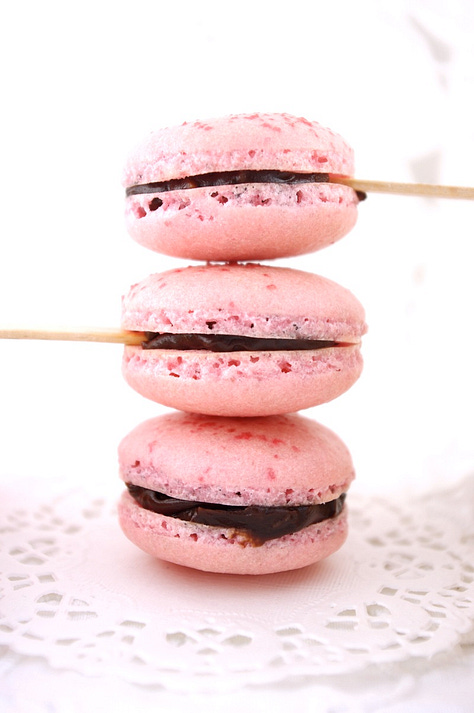
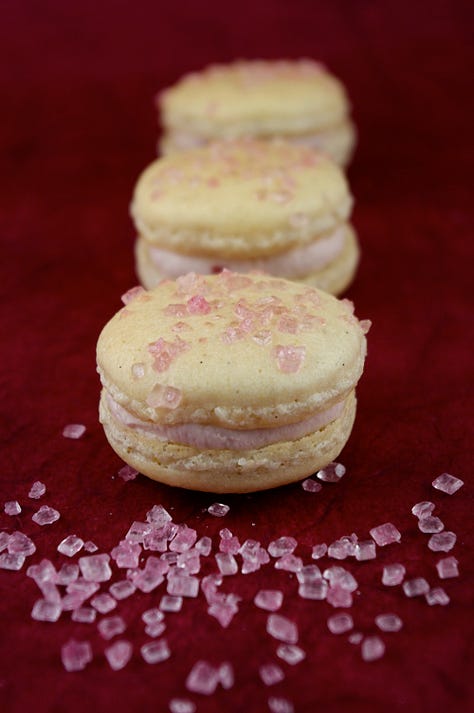
Chocolate Gingerbread Macarons with chocolate ganache filling
A cross between a chocolate and a pastry, the macaron is a luxury and a bit of a mystery. And making them seems so very daunting. This recipe, if you can master beating egg whites until really thick and then master the delicate art of folding the whites into the mix of ground almonds and sugar, then piping them out, this recipe is the simplest - using plain French meringue rather than cooked Italian meringue. And I find that adding cocoa powder somehow stabilizes the batter and these are the only ones that always come out perfect every time I make them. But, to be honest, making Parisian macarons does take both patience and practice. So worth the effort.
This is my favorite macaron flavor combination; although these macarons are fabulous made only with cocoa powder, the touch of gingerbread spice adds a wonderfully festive touch to these delectable chocolate macarons, balancing perfectly with the chocolate without overpowering it.
Macarons
7 ounces (200 grams) confectioner’s (powdered/icing) sugar
4 ounces (115 grams) finely ground almonds
3 large eggs whites (about 3.5 ounces / 100 grams)
1.2 ounces (35 grams) granulated white sugar, about 2 tablespoons
1 teaspoons ground gingerbread (pain d’épices) spices, optional but good
2 teaspoons unsweetened cocoa powder
Chocolate Ganache
½ cup (125 ml) heavy cream
3.8 – 4 ounces (110 – 115 grams) dark chocolate
You will need a stand or hand mixer, large baking sheets and ovenproof parchment paper, a pastry bag with a round tip (with about a ⅝ inch /1 ½ cm opening).
Prepare 2 large baking sheets. On 2 large pieces of white paper the size of your baking sheets, trace 1 – inch diameter circles (I used the wide end of my pastry tip) evenly spaced with a pencil, leaving about ¾ – 1 inch between each circle. This will be your template to help you pipe even circles of batter onto the parchment paper. You will be able to reuse these templates endlessly. Place one paper on each baking sheet then cover with parchment paper. Set aside. Prepare a pastry bag with a plain tip.
Prepare the macaron batter. Sift the confectioner’s sugar and the ground almonds into a large mixing bowl. (This might take a bit of time.) Blend the cocoa powder and spice together with the sifted powdered/icing sugar and ground almonds and whisk to blend.
In a standing mixer or with a hand mixer, beat the egg whites for 30 seconds on low speed then increase speed to high and beat until the whites are foamy. (NOTE: egg whites whip better in a plastic or metal bowl rather than glass). Gradually add the granulated sugar as you continue to whip the whites until you obtain a glossy meringue and all of the sugar has been beaten in. The meringue will be very stiff (turn the bowl upside down over your head and they shouldn’t move) and be dense like marshmallow.
Gently but firmly fold the whipped whites into the powdered sugar/ground almonds/cocoa, using a silicon spatula or the equivalent, turning the bowl as you lift and fold, making sure you scrape and lift from the bottom in order to fold in all the dry ingredients completely. When the batter is ready to pipe, it should flow from the spatula like lava or a thick ribbon. To test to see if you have folded it enough, drop a small amount onto a clean plate and jiggle it slightly. The top should flatten, not remain in a point. If it doesn’t flatten, give the batter a few more folds and test again. You can also fold the powdered mixture into the meringue if it is easier for you.
Pipe out the rounds. Fill your pastry bag with the batter. Pipe circles onto the parchment paper, using the traced circles on the template sheets to guide you, holding your pastry bag above each circle and piping into the center. DO NOT FORGET TO CAREFULLY REMOVE THE WHITE PAPER TEMPLATE FROM UNDERNEATH THE PARCHMENT PAPER. YOU DO NOT WANT THIS PAPER TEMPLATE TO GO IN THE OVEN!
Preheat your oven to 280°F (140°C).
Allow the macarons to sit out for about an hour or even longer until the shells are ready to bake. The top of each shell should form a “skin” (it will feel like it hardened a bit when gently touched and not stick to your finger). Bake the shells for 15 – 25 minutes, depending on their size (gently touch a shell or a 2 and if the top jiggles a bit as if there is still a bit of liquid batter between the top and the “feet” just let it continue to bake another minute before testing again.) I turn the baking trays back to front halfway through the baking.
Remove the tray from the oven and immediately slide the parchment paper with the shells off of the hot baking sheet and onto a surface, table or countertop. Allow to cool completely before sliding the shells very gently off of the parchment by slipping a metal cake spatula under the shell as you lift it up or by peeling the parchment paper from the back of the shells. Do this slowly and carefully or the center of the shell risks sticking to the parchment.
Prepare the Chocolate Ganache: Coarsely chop the chocolate and place it in a heatproof bowl. Heat the heavy cream just to the boil and pour over the chopped chocolate. Stir until smooth and creamy. Allow to cool, stirring occasionally, until desired piping consistency.
When the macaron shells are cool, pair the shells up evenly, each with a matching partner. Pipe a ½ to 1 teaspoon of the ganache onto the bottom shell of each pair. Carefully sandwich the shells together.
Thank you for subscribing to my Substack, Life’s a Feast by Jamie Schler, where I share my (mostly French) recipes, my hotel and my jams, my projects, and the stories of my life. You can support my work by sharing the link to my Substack with your friends, family, and your social media followers. You can also follow me on Notes. I’m so glad that you’re here.
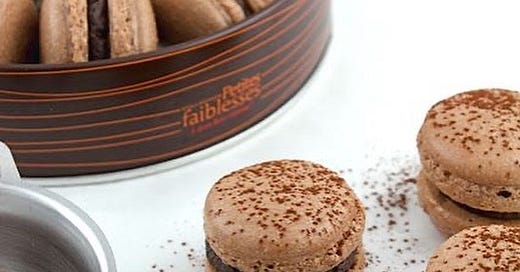



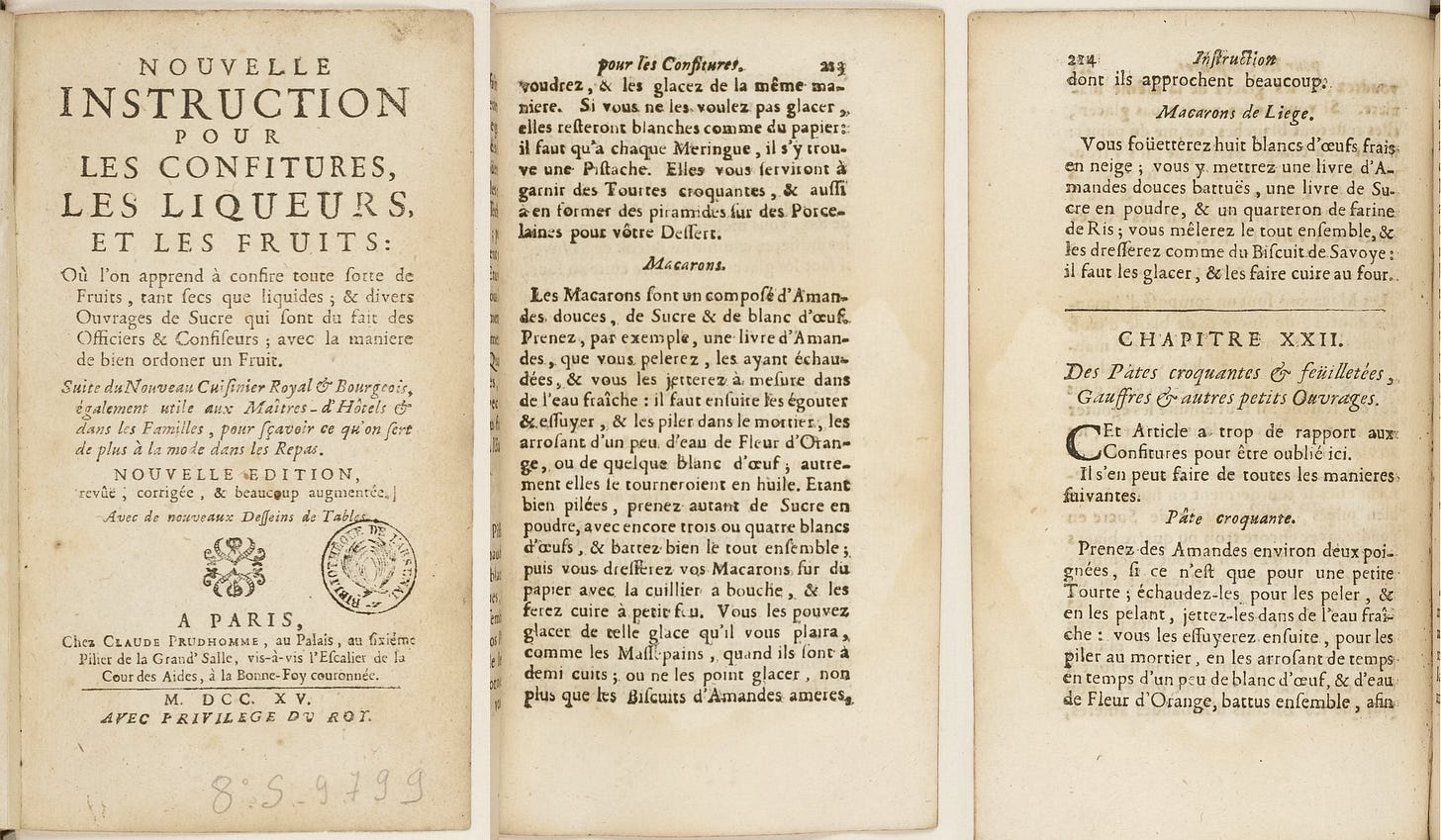
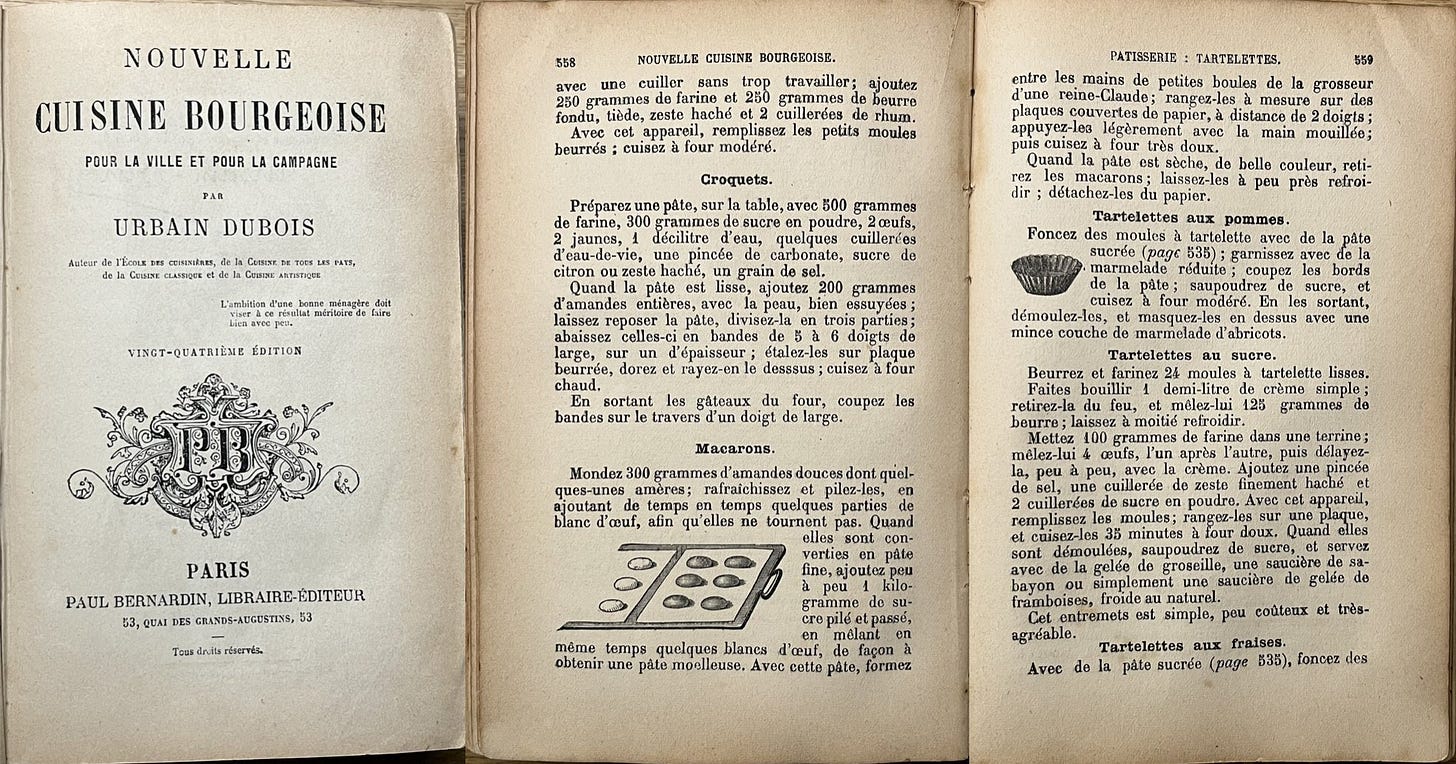
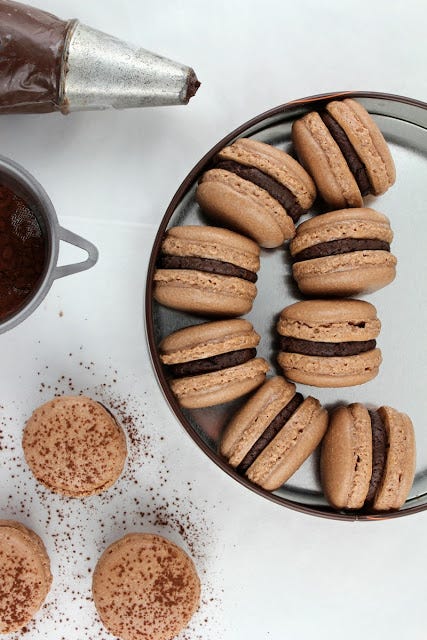
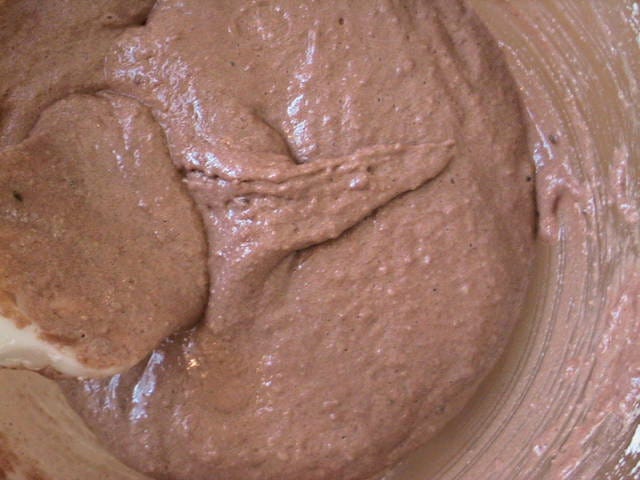
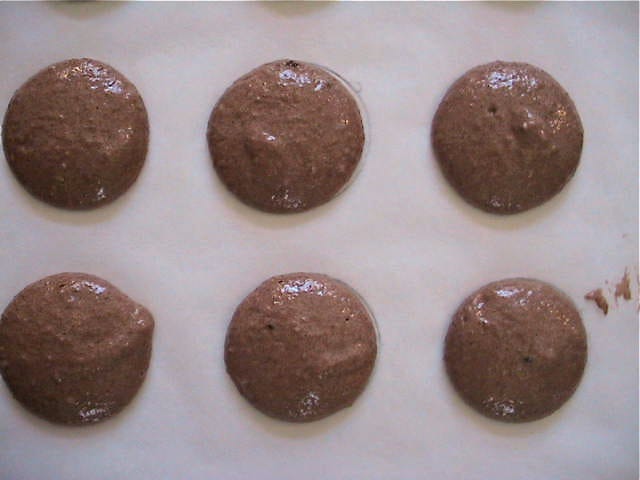
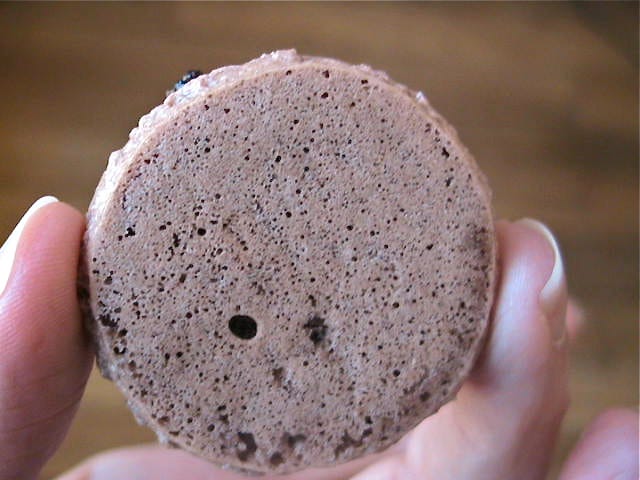
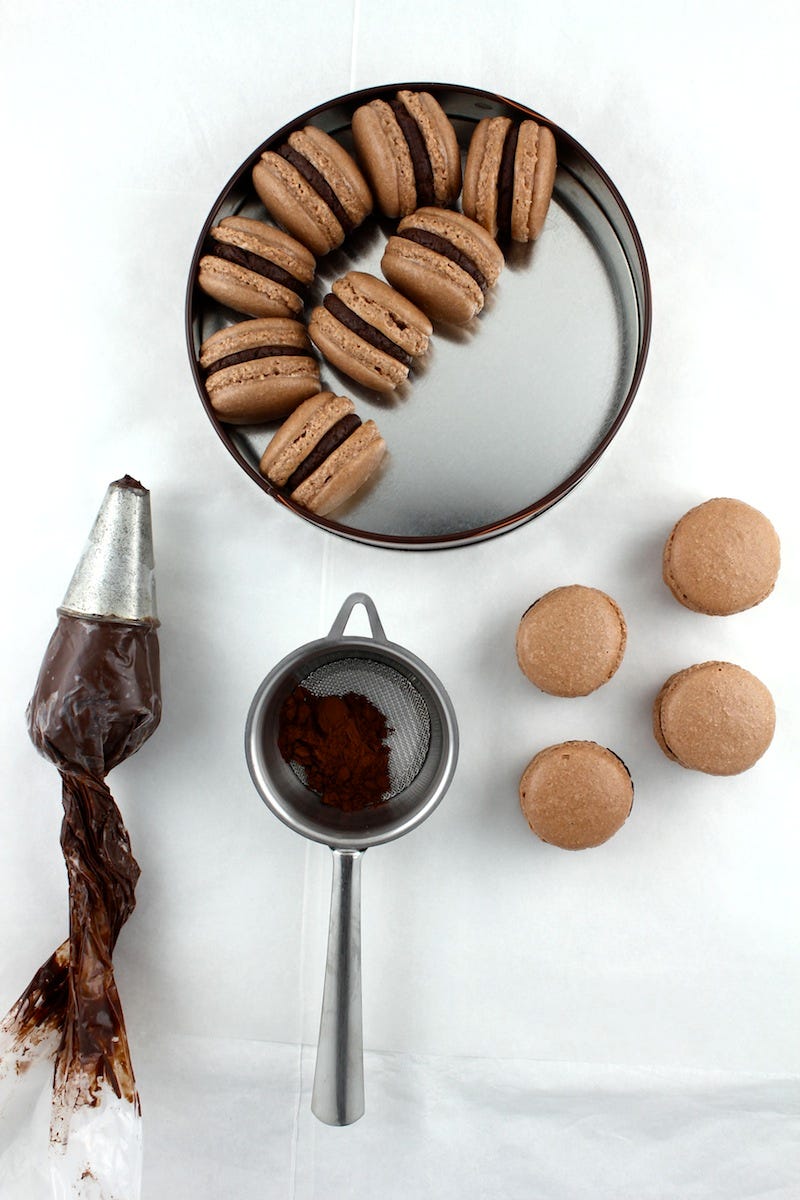
At my very first restaurant cooking job one of our snacks was a savoury macaron flavoured with cheese and truffle. Really lovely. Do you ever come across savoury ones in France?
Love this. Thanks for the history lesson!